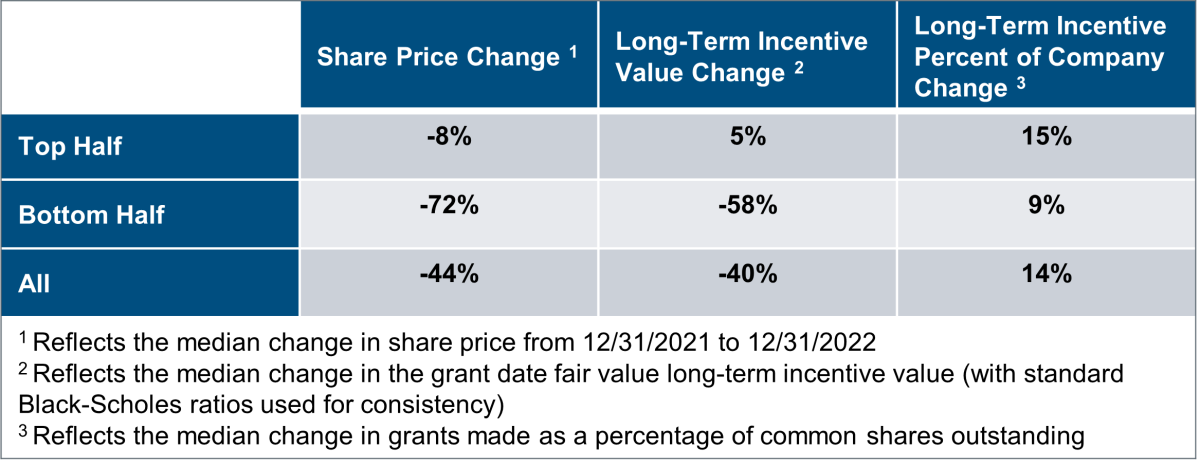
Advisor Blog | Jan 2023
Juggling Biotech Equity Grant Size, Dilution, and Retention
A decline in share prices creates challenges in the current equity grant cycle. Our data show how biotech companies are making adjustments.
2022 was a challenging year for biotech companies on many fronts. After a protracted period of growth, abundant access to capital, and share price gains, companies experienced the opposite last year. The decline in share prices created particular challenges for human resource heads and compensation committees going into a new annual compensation cycle. Companies are grappling with how to size new annual equity grants in an environment where share prices are down 30 to 50 percent. Engagement and retention remain quite important, but companies must balance the desire to deliver competitive long-term incentive values to their executives and key talent with the resulting dilution given current share prices.
To better understand how biotech companies might be adjusting their equity grant sizing approach, Pearl Meyer has conducted a matched sample comparison of CEO equity grants from 2022 and 2023. The purpose of this research is to get an early sense of how grants are being sized for the benefit of other companies that may be making grants later in January or February. For 2023, we captured CEO grants over the last month, as compared to those same individual CEOs grants last year.
Our research identified 40 pre-commercial biotech companies. This group of companies has a median market capitalization of approximately $170M, down from approximately $380M the year prior. Our initial findings show that companies are reducing the value of grants year-over-year but increasing the percentage of the overall equity in the company that the CEO receives. The median equity grant size when expressed as a percentage of the company’s common shares outstanding increased by 14 percent in 2023 versus 2022. However, the value of those same grants was 44 percent lower than last year.
Further segmenting the sample by top and bottom performers (as defined by stock price performance), we found that those that experienced the most share price decline saw their LTI values decline the most (58 percent decline versus five percent increase), however their grants as a percent of common shares outstanding were reasonably close to those that had better share price performance (nine percent increase versus 15 percent increase).

This dynamic illustrates that, in the end, long-term incentive values are highly sensitive to share price performance, and although used as a common benchmark, need to be balanced against more stable metrics like long-term incentive grants as a percentage of the company’s common shares outstanding.
It is also apparent that in unusual times like these, there is no strict formula for the decision-making factors around equity. Companies need to weigh other factors such as the strength of the management team, the level of exposure to retention given that previous grants may be underwater, the overall stability of the company, and other important factors.
Companies with evergreen* features in the equity plan will have much greater flexibility to allocate equity to their employees in 2023 due to the automatic annual replenishment of shares, the full weight of which is not always required during “normal” times. However, companies that don’t have an evergreen feature and that feel burdened by a low share reserve, will need to carefully consider the best use of their remaining shares. To do this, compensation committees should work closely with their HR heads to model upcoming share needs, understand potential shortcomings, and adjust their approach to long-term incentives accordingly. This can include a review of the incentive vehicles, the equity mix, grant timing, and plan participation. Alternatively, committees will need to weigh the pros and cons of seeking shareholder approval to expand the equity pool in 2023.
*An “evergreen” feature gives the board of directors the authority to automatically increase the pool of available shares at the beginning of each year; the provision is typically structured as the lesser of a percent of common shares or a number as determined by the board.

